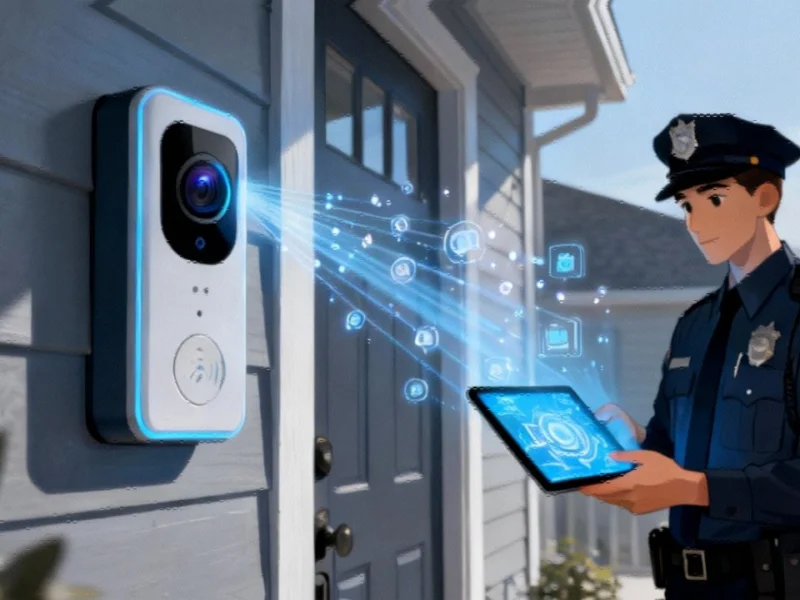Note: Featured image is for illustrative purposes only and does not represent any specific product, service, or entity mentioned in this article.
Strategic Partnership Enables New Law Enforcement Access Model
Amazon’s Ring has entered a significant partnership with Flock Safety that creates a streamlined pathway for law enforcement agencies to request footage from residential surveillance systems. This collaboration marks a notable shift in Ring’s approach to police cooperation after several years of distancing its products from law enforcement channels. The integration allows agencies using Flock’s Nova platform or FlockOS to leverage Ring’s “Community Requests” program, creating a unified surveillance network that spans both residential and public spaces.
The timing of this partnership coincides with broader market trends in security technology integration. Industry observers note that the merger of these surveillance networks represents a significant evolution in how law enforcement can access distributed camera systems without requiring individual warrants for each device.
Privacy Safeguards and Investigative Protocol
According to the partnership framework, law enforcement agencies must provide specific investigative details before making footage requests. Required information includes the precise location and timeframe of incidents, unique investigation codes, and descriptions of what investigators are seeking. This structured approach aims to balance investigative needs with privacy considerations, though digital rights advocates have expressed concerns about the scale of potential access.
The system maintains user anonymity throughout the process, with Ring customers remaining unidentified regardless of whether they choose to share footage. The optional nature of participation means homeowners can decline requests without notifying authorities of their decision. This aspect of the program reflects ongoing related innovations in privacy-preserving surveillance technology.
Historical Context and Strategic Shifts
Amazon and Ring’s relationship with law enforcement has undergone multiple transformations. The company removed warrantless video request capabilities in 2024, but previous years saw documented cases of direct police access to footage. The current pivot toward closer cooperation appears linked to Ring founder Jamie Siminoff’s return to leadership in April 2025, signaling a renewed focus on law enforcement as a key market segment.
This strategic realignment occurs alongside Amazon’s broader push to market its cloud and AI services to police agencies. The Flock partnership represents one component of a comprehensive strategy to position Amazon technologies at the center of modern policing infrastructure. These industry developments highlight how major technology providers are increasingly targeting public safety applications.
Flock’s Controversial Surveillance Network
Flock Safety brings its own complex history to the partnership. Reports indicate that Immigration and Customs Enforcement (ICE) has used Flock’s surveillance tools to locate and detain individuals without a formal contract. Additional documentation shows that Navy and Secret Service personnel have accessed Flock’s camera network, raising questions about the scope of government access to combined Ring-Flock surveillance data.
While Ring isn’t directly implicated in Flock’s previous government collaborations, the partnership creates infrastructure connections that privacy experts find concerning. The integration effectively links Ring’s extensive residential camera network with Flock’s established law enforcement access channels, potentially creating one of the largest privately-operated surveillance systems available to government agencies. This expansion occurs amid wider recent technology infrastructure changes that enable more extensive data collection and sharing.
Industry Implications and Future Outlook
The Ring-Flock partnership exemplifies how residential and commercial surveillance systems are converging into integrated networks. As detailed in our priority coverage of this development, the collaboration could set a precedent for other smart home manufacturers considering similar law enforcement integrations.
For consumers, the partnership raises important questions about the evolution of privacy in an increasingly connected home environment. While the current system remains opt-in, the infrastructure now exists for more extensive law enforcement access should policies change in the future. These developments are occurring within a broader context of industry developments that are reshaping how technology companies interact with government agencies.
Looking ahead, the success of this partnership will likely influence how other smart device manufacturers approach law enforcement collaboration. The balance between investigative utility and personal privacy will continue to evolve as these surveillance networks expand and become more sophisticated in their integration capabilities.
This article aggregates information from publicly available sources. All trademarks and copyrights belong to their respective owners.
